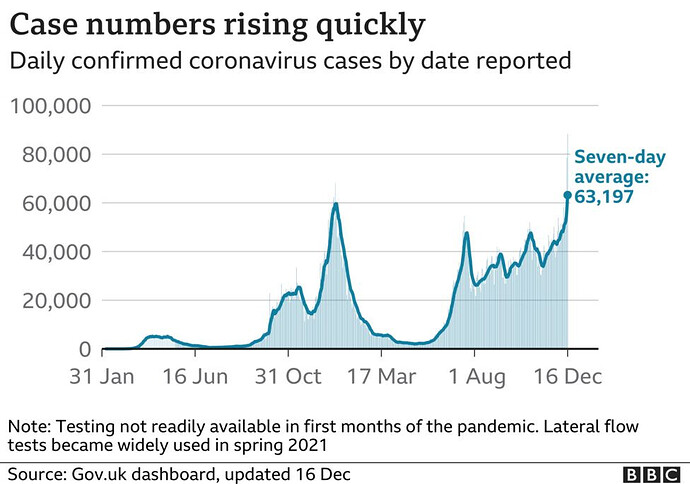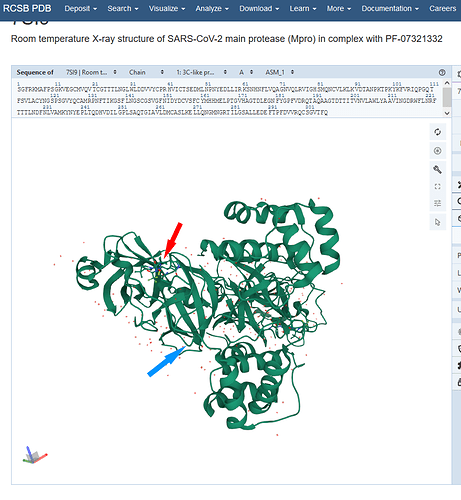thanks for the quick response, also thanks for making this understandable at my level.
I have a hunch that Omicron sheds more into wastewater than other variants for some reason. The wastewater spikes seem a lot more extreme than anything going on in cases.
Not really. I still owe something like $100 for a COVID test in America that I took early last January. No interest in paying it.
Turkey has declared it will join countries accelerating the schedule for vaccine booster shots to fight the spread of the Omicron variant.
Turkey’s health minister Fahrettin Koca said that as a “precaution,” citizens and residents who received their second dose three months ago can now register for boosters.
Over 82 percent of Turkish residentshave received two doses of a vaccine according to the Turkish government, primarily Pfizer-Biontech. Turks who were previously vaccinated with Sinovac-Coronavac were offered additional shots of Pfizer-Biontech earlier this year.
Turkish officials reported the first cases of the Omicron variant last Saturday, one in Istanbul and five in the southern city of Izmir. The governor of Izmir, Yavuz Selim Köşger, told journalists that none of those infected had “connections abroad,” indicating community spread.
UK#1
- The UK recorded its highest tally of lab-confirmed Covid cases since the pandemic began – for the second day running – with almost 90,000 new infections. Independent SAGE said it’s urging a circuit-breaker lockdown until 24 December.
The highly-mutated Omicron variant could swamp intensive care capacity in Ontario, Canada within weeks without action, a panel of experts said on Thursday.
“This will likely be the hardest wave of the pandemic. There is still some uncertainty but there is an undeniable urgency,” said Adalsteinn Brown, co-chair of Ontario’s Covid advisory group. “Waiting to take action means waiting until it is too late to take action.”
Canada reported 5,810 new Covid cases on Wednesday, an 85% jump from 3,146 infections two weeks beforehand.
Italy reported 26,109 new Covid cases on Thursday, its highest daily number since 26,790 new infections on 12 March.
Today’s tally is a 90% surge on Italy’s 13,756 new cases three weeks ago.
Look, we don’t have to just fearmonger guess about this. We know how and where the drug binds in the protease. We know that binding to the active site is almost certainly the drug’s one and only mechanism of action for inhibiting the virus. We also know exactly how many mutations the omicron version of the protease has relative to Wuhan:
One
So, we can crack open the PDB and take a look for ourselves:
The drug is seen bound at the top of the molecule in a ball-and-stick representation and highlighted by the red arrow. The one mutation is changing proline 132, pointed at by the blue arrow right at that kink turn in the ribbon diagram, to a histidine. That’s a fairly material change in some respects, but it’s well away from the binding/active site. The main way this would block inhibitor binding would be through inducing a large conformational change in the protein, something we know to be highly unlikely, because such a change would likely inactivate the enzyme, and omicron still needs its protease to replicate. And oh, by the way, they’ve just straight up tested the binding of the drug to the omicron variant protease, and it still binds with high affinity. Unlike with vaccines, that, one, targeted a place with a lot more mutations, and two, act by inducing a complex host immune response including a bunch of random antibody generation such that it’s difficult to know how any one mutation to an antibody target may impact antibody binding, a small molecule drug that inhibits an enzyme by binding to its active site only has to function by binding to the active site, so it’s exceedingly unlikely that a drug that binds in exactly the same way is rendered ineffective by some other unrelated mutation. Sure, anything is possible in biology, and maybe, just maybe, this one mutation created a super duper drug binding site on the back side of the protein so that the drug binds there now and leaves the active site open and available for protease activity (something that can also be tested in vitro, natch), but, uh, the available evidence makes a strong case that this just isn’t the case.

Serious question - does the Queen have someone that wipes her butt for her? That would be so weird.
Wikipedia tells me the office of “Groom of the Stool” was discontinued by King Edward VII in 1901.
That makes me feel better. So the Royals do evolve, just very very slowly compared to the rest of the world.
One of the first people to cancel an event due to Omicron, seems like she adapts pretty quick.
New Joe Rogan nickname nice!
Not the pre-Christmas family lunch!

The queen is old enough that there is some chance she has one.
Lord Protector of the Royal Antechamber?
Discovery Health, South Africa’s largest private health insurance administrator, releases at-scale, real-world analysis of Omicron outbreak based on 211 000 COVID-19 test results in South Africa, including collaboration with the South Africa
Facebook
LinkedIn
Twitter
Download as PDF
Johannesburg, 14 December 2021
Summary:
- Vaccine effectiveness :
- o The two-dose Pfizer-BioNTech vaccination provides 70% protection against severe complications of COVID-19 requiring hospitalisation, and 33% protection against COVID-19 infection, during the current Omicron wave.
- Reinfection risk: For individuals who have had COVID-19 previously, the risk of reinfection with Omicron is significantly higher, relative to prior variants.
- Severity : The risk of hospital admission among adults diagnosed with COVID-19 is 29% lower for the Omicron variant infection compared to infections involving the D614G mutation in South Africa’s first wave in mid-2020, after adjusting for vaccination status
- Children : Despite very low absolute incidence, preliminary data suggests that children have a 20% higher risk of hospital admission in Omicron-led fourth wave in South Africa, relative to the D614G-led first wave.
Reuters summary here…
The findings from the real-world analysis are some of the first about the protection vaccines offer against Omicron outside of laboratory studies, which have so far shown a reduced ability to neutralise the virus.
South African scientists sent 630 positive COVID-19 tests for genome sequencing in November to see if they were Omicron and another 61 so far in December. Last month, 78% were confirmed as Omicron and all 61 this month were the new variant.
‘CONFOUNDING FACTOR’
Discovery cautioned that the study’s findings should be considered preliminary. Michael Head, senior research fellow in global health at the University of Southampton, also said there was a large degree of uncertainty for now about Omicron.
“It is important to avoid inferring too much right now from any national scenario. For example, the narrative around South Africa is that Omicron may be much milder, whereas reports out of Denmark broadly suggests the opposite,” he said.
The study concluded there was a higher risk of reinfection during the fourth wave than during previous waves and the risk of hospitalisation among adults diagnosed with COVID-19 was still 29% lower than during the country’s first wave last year.
Children appeared to have a 20% higher risk of hospital admission with complications during the fourth wave than during the first, despite a very low absolute incidence, it said.
“This is early data and requires careful follow up,” said Shirley Collie, chief health analytics actuary at Discovery Health.
However, this trend aligns with a warning in recent days from South Africa’s National Institute for Communicable Diseases (NICD) that during the country’s third wave from June to September they had seen an increase in paediatric admissions and now, in the fourth wave, they are seeing a similar increase in admissions for children under five, she said.
South African scientists have said they cannot confirm a link between Omicron and the high admissions of infants, which could be due to other factors.
The WHO has said there were early signs that vaccinated and previously infected people would not build enough antibodies to ward off an Omicron infection, resulting in high transmission rates, but was unclear whether Omicron was inherently more contagious than the globally dominant Delta variant.
One of my account teams at work was supposed to have a holiday party tonight. It’s been on the books for a while and I hadn’t thought much about it–we have a vax mandate and require folks to upload their CDC cards as proof. Just as I was getting ready to head out the door my gf got a text from one of her friends, a recent contact, who had tested positive for COVID. The contact was 5 days ago, and the gf has been boosted for a few weeks and she feels fine. I think there’s basically zero chance I have COVID but I can’t take the chance, so I’m canceling. Pretty bummed.
It also made me consider how many people would do the same in my shoes. Probably everyone here (I’m guessing most wouldn’t have gone at all  ) but probably not many of the general population. I assume the standard response would be “my gf feels fine, I feel fine, I’m probably fine, I’m gonna go” but, as shitty as I feel not going, I’d feel even shittier if it came out that I brought COVID to a gathering one week before Christmas.
) but probably not many of the general population. I assume the standard response would be “my gf feels fine, I feel fine, I’m probably fine, I’m gonna go” but, as shitty as I feel not going, I’d feel even shittier if it came out that I brought COVID to a gathering one week before Christmas.
Blah.
In unrelated news, I’m still pretty achy ~22 hours after the booster but otherwise feel OK.
A lot of the real damage that is done by Covid is due to secondary issues like pneumonia and blood clots, such that I suspect waiting till somebody is severely ill / in the hospital is probably too late. That’s just my total conjecture though, I’d be curious what @CaffeineNeeded and @MrWookie think.

